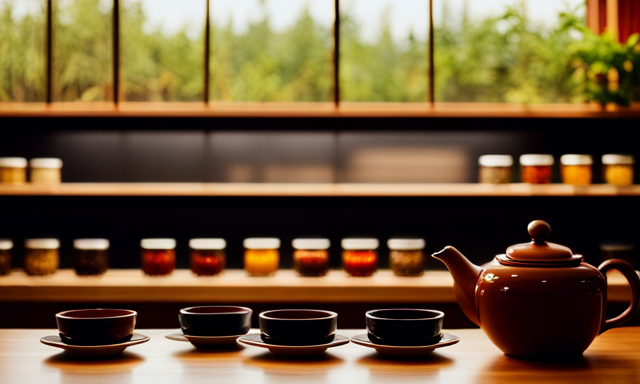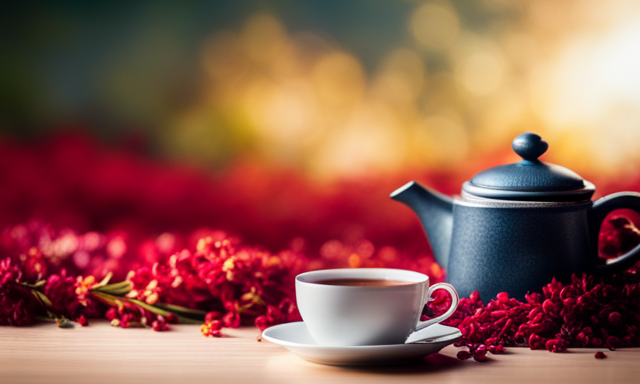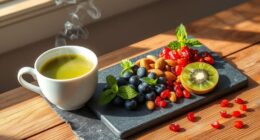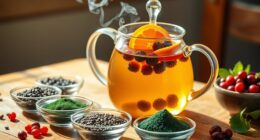As I sip on my cup of rooibos tea, I am reminded of the soothing embrace of a warm hug on a chilly winter’s day. This magical brew, native to the rugged mountains of South Africa, holds within its ruby-red depths a world of wonders.
Derived from the Aspalathus linearis plant, rooibos tea is not your average beverage. It is a treasure trove of nutrients, offering a plethora of health benefits that go beyond merely quenching your thirst.
In this article, we will dive deep into the origins and history of rooibos tea, exploring its nutritional composition and uncovering the truth behind common myths and misconceptions. We will also delve into the enchanting flavors that dance on your taste buds with each sip.
From the sustainable practices employed in its production to its place in popular culture and traditional medicines, this article will be your guide to all things rooibos tea. So, sit back, relax, and allow me to take you on a journey through the captivating world of rooibos tea.
Key Takeaways
- Rooibos tea is produced using sustainable farming practices that prioritize soil health, water conservation, and biodiversity.
- Fair trade certification ensures that the tea production involves fair wages and safe working conditions for workers.
- Rooibos tea is low in calories, high in antioxidants, and may potentially aid in weight management by boosting metabolism, increasing fat oxidation, and suppressing appetite.
- Rooibos tea is culturally significant in South African heritage and is used in beauty products due to its antioxidant and anti-inflammatory properties, which calm and rejuvenate the skin, fight acne, promote even skin tone, strengthen hair follicles, prevent hair loss, nourish the scalp, and reduce dandruff.
Origins and History of Rooibos Tea
Did you know that rooibos tea has a fascinating history and originates from the beautiful lands of South Africa?
The origins of rooibos tea can be traced back to the indigenous Khoisan people, who were the first to discover the unique properties of the Aspalathus linearis plant.
For centuries, rooibos tea has been an integral part of the Khoisan culture, playing a significant role in their daily lives and traditional ceremonies.
Today, rooibos tea is not only enjoyed for its delicious flavor and health benefits, but it also holds cultural significance as a symbol of South African heritage.
Its rich history and cultural importance make rooibos tea a truly special beverage.
Now, let’s delve into the nutritional composition of rooibos tea.
Nutritional Composition of Rooibos Tea
The nutritional composition of rooibos tea includes a rich blend of antioxidants and minerals, making it a healthy and refreshing beverage option. It contains several key nutrients that contribute to its health benefits.
-
Antioxidants: Rooibos tea is packed with powerful antioxidants like aspalathin and quercetin, which help protect the body from free radicals and reduce inflammation.
-
Minerals: This tea is a good source of minerals such as calcium, magnesium, and potassium, which are essential for maintaining healthy bones, muscles, and blood pressure levels.
-
Polyphenols: Rooibos tea contains polyphenols, which have been linked to various health benefits, including improved heart health and reduced risk of chronic diseases.
The nutrient content of rooibos tea, combined with its delicious taste and soothing properties, make it a popular choice among health-conscious individuals.
In the next section, we will explore the numerous health benefits that rooibos tea offers.
Health Benefits of Rooibos Tea
Experience the incredible health benefits of rooibos tea, as it nourishes your body with a rich blend of antioxidants and minerals, leaving you feeling refreshed and revitalized.
Rooibos tea has been shown to promote heart health by reducing inflammation and improving blood circulation. It contains quercetin, a powerful antioxidant that helps protect against cardiovascular diseases.
Additionally, rooibos tea aids in digestion by soothing the digestive system and relieving common gastrointestinal issues such as indigestion and stomach cramps. Its anti-spasmodic properties help to relax the muscles of the intestines, promoting smoother digestion.
Transitioning into the subsequent section about the flavor profile of rooibos tea, it’s important to note that while the health benefits are impressive, the taste of rooibos tea is equally delightful.
Flavor Profile of Rooibos Tea
Indulge in the rich and aromatic flavors of rooibos tea, as it delights your taste buds with its natural sweetness and hints of nuttiness. The flavor profile of rooibos tea is truly unique and offers a delightful experience for tea enthusiasts.
One of the great things about rooibos tea is that it can be enjoyed both hot and iced, catering to different flavor preferences. When brewing rooibos tea, it’s important to use water that’s just below boiling point to preserve its delicate flavors. Steeping it for around 5-7 minutes allows the tea to fully infuse and develop its rich taste.
Rooibos tea can be enjoyed plain or with a touch of honey or lemon for added sweetness.
Transitioning into the next section, let’s explore how rooibos tea is prepared and served.
How Rooibos Tea is Prepared and Served
When it comes to preparing and serving Rooibos tea, there are a few traditional brewing methods that can enhance its flavor and aroma.
One popular method is to steep the tea leaves in boiling water for about 5-7 minutes, allowing the natural sweetness and earthy notes to fully infuse.
Another option is to use a French press, which helps to extract even more of the tea’s essence.
Additionally, for those who prefer a refreshing twist, there are various recipes available for making delicious iced Rooibos tea, incorporating ingredients like lemon, mint, or fruit for a delightful and cooling beverage.
Traditional Brewing Methods
Although rooibos tea is traditionally brewed by steeping the leaves in hot water, some may argue that the lack of caffeine might make it less appealing. However, traditional brewing techniques have been passed down through generations and hold great cultural significance.
To prepare rooibos tea in a traditional manner, start by bringing water to a boil. Then, add the rooibos leaves to a teapot and pour the hot water over them. Allow the tea to steep for about 5 to 7 minutes to extract the rich flavors. Finally, strain the tea into cups and serve it hot.
The traditional brewing method ensures that the full potential of the rooibos leaves is unlocked, resulting in a flavorful and aromatic tea.
Moving forward to the subsequent section about iced rooibos tea recipes, let’s explore how this versatile beverage can be enjoyed cold as well.
Iced Rooibos Tea Recipes
One way to enhance the refreshing qualities of iced rooibos is by infusing it with a medley of fresh fruits and herbs. By adding these flavorful ingredients, you can create a variety of iced rooibos tea flavors that are both delicious and invigorating. For a tropical twist, try infusing your rooibos tea with slices of juicy pineapple and a sprig of mint. Or, for a more citrusy option, add a squeeze of lemon and a few slices of orange. And if you’re feeling adventurous, why not experiment with rooibos tea cocktails? Mix your iced rooibos with a splash of rum, a squeeze of lime, and a touch of honey for a refreshing summer drink. Now, let’s move on to the next topic, the difference between green rooibos and fermented rooibos.
The Difference Between Green Rooibos and Fermented Rooibos
Indulge in the soothing embrace of green rooibos, a symbol of nature’s untouched purity, and experience its gentle and invigorating qualities. Green rooibos is known for its numerous health benefits, including its high antioxidant content that helps protect the body from free radicals. It’s also rich in vitamins and minerals, such as vitamin C, calcium, and magnesium, which support overall well-being.
When it comes to flavor, fermented rooibos has a distinct taste profile that’s often described as earthy, sweet, and slightly nutty. On the other hand, green rooibos has a lighter and more delicate flavor, with notes of grass and herbs. This makes it a refreshing and rejuvenating choice for those who prefer a milder taste.
Transitioning into the subsequent section about sustainability and fair trade practices in rooibos tea production, it’s important to consider the ethical aspects of this beloved beverage.
Sustainability and Fair Trade Practices in Rooibos Tea Production
After exploring the difference between green rooibos and fermented rooibos, I’m now eager to delve into the sustainability and fair trade practices in rooibos tea production.
It’s crucial to understand how our consumption choices impact the environment and the communities involved in the tea-making process.
Many rooibos tea producers are committed to sustainable farming practices, which prioritize soil health, water conservation, and biodiversity. These practices ensure that the land remains fertile and productive for future generations.
Additionally, fair trade certification ensures that workers involved in the production are paid fair wages and work in safe conditions.
By supporting sustainable farming practices and fair trade, we can contribute to a more equitable and environmentally conscious tea industry.
Now, let’s address some common myths and misconceptions about rooibos tea.
Common Myths and Misconceptions about Rooibos Tea
Rooibos tea is often hailed as a potential weight loss aid due to its low calorie content and high antioxidant levels. While it may have some benefits for weight management, it is important to remember that no single food or drink can magically make you lose weight.
Similarly, although some people claim that rooibos tea can cure skin conditions like acne or eczema, there is limited scientific evidence to support these claims. It’s always best to consult with a healthcare professional before relying on rooibos tea or any other product as a cure for skin conditions.
Rooibos Tea as a Weight Loss Aid
Boost your weight loss journey with the natural benefits of Rooibos tea. This herbal infusion has gained popularity as a potential aid in shedding those extra pounds. Scientific research suggests that Rooibos tea may help with weight loss due to its high levels of antioxidants and polyphenols. These compounds have been shown to boost metabolism, increase fat oxidation, and suppress appetite.
Furthermore, Rooibos tea can help stabilize blood sugar levels, preventing cravings and promoting a feeling of fullness. Incorporating Rooibos tea into your daily routine can be a simple and effective way to support your weight loss goals.
So, why not sip on a cup of this delicious tea and give your body a helping hand in achieving a healthier you?
Speaking of health benefits, let’s dive into how Rooibos tea can also work wonders for your skin.
Rooibos Tea as a Cure for Skin Conditions
Imagine a world where your skin’s free from the shackles of conditions, and you can revel in the beauty of a clear and radiant complexion. Rooibos tea, with its remarkable healing properties, offers hope for those suffering from skin conditions like eczema and acne. This natural wonder acts as a cure for eczema by reducing inflammation and soothing irritated skin. Its antioxidant-rich nature helps in the treatment of acne, preventing breakouts and promoting healthier skin. Incorporating rooibos tea into your skincare routine can provide relief and improvement in these conditions.
To fully appreciate the benefits of rooibos tea for your skin, consider the following:
- Soothes inflammation and irritation
- Reduces redness and dryness
- Promotes a clearer and healthier complexion
With its proven effectiveness, rooibos tea proves to be a valuable addition to any skincare regimen. But rooibos tea’s wonders don’t stop there. Let’s delve into its role in popular culture and traditional medicines, where its rich history and cultural significance are revealed.
Rooibos Tea in Popular Culture and Traditional Medicines
Rooibos tea holds a significant place in South African heritage, with its rich history and cultural importance.
In addition to being enjoyed as a beverage, rooibos tea has also found its way into beauty products. Its antioxidant and anti-inflammatory properties make it a popular ingredient in skincare products, offering various benefits for the skin.
South African Heritage
Discover the rich heritage of South Africa through the unique flavors of rooibos tea. Rooibos tea has deep cultural significance in South African traditions, and it’s a key part of our heritage.
For centuries, the indigenous people of South Africa have cherished this tea for its healing properties and its ability to bring people together. It’s often served during important gatherings and ceremonies, symbolizing unity and community.
The warm, earthy taste of rooibos tea is a reflection of the land it comes from, and it’s a true representation of our South African roots.
As we explore the various uses of rooibos tea, we’ll delve into its role in beauty products and how it can benefit our skin and hair.
Rooibos Tea in Beauty Products
Indulge in the beauty benefits of incorporating rooibos tea into your skincare routine, and watch your skin and hair flourish like a well-watered garden. Rooibos tea, with its rich antioxidant properties, is a hidden gem for achieving a radiant complexion and luscious locks. Here’s why you should consider adding rooibos tea to your beauty arsenal:
-
Rooibos tea in skincare routine: This soothing tea helps to calm and rejuvenate the skin, reducing redness and inflammation. It also aids in fighting acne and promoting a more even skin tone.
-
Rooibos tea in hair care products: The natural enzymes and minerals found in rooibos tea can strengthen hair follicles, preventing hair loss and promoting healthy growth. It also nourishes the scalp, reducing dandruff and adding shine to your tresses.
Now that you know the amazing benefits, let’s delve into where to buy rooibos tea and how to store it properly, ensuring you always have this beauty elixir at your fingertips.
Where to Buy Rooibos Tea and How to Store It Properly
When you’re craving the rich and soothing taste of rooibos tea, you’ll want to know where to find it and how to keep it fresh for the perfect cup every time. Luckily, there are several reputable online stores where you can buy rooibos tea. Websites like Amazon, Teavana, and Adagio Tea offer a wide range of options, from traditional rooibos to flavored blends. Before making a purchase, be sure to read customer reviews and check for certifications to ensure you’re getting a high-quality product.
Proper storage is essential to maintain the freshness and flavor of rooibos tea. The best way to store it is in an airtight container, away from light, moisture, and strong odors. Keep it in a cool, dry place, such as a pantry or cupboard. Avoid storing it near spices or coffee, as rooibos easily absorbs odors. If stored properly, rooibos tea can stay fresh for up to two years. To extend its shelf life, consider dividing larger quantities into smaller portions and only opening them as needed.
So, whether you’re a seasoned rooibos tea lover or just discovering its wonders, knowing where to buy it online and how to store it properly will ensure you always have a flavorful and refreshing cup of this delightful tea.
Frequently Asked Questions
Can rooibos tea be consumed during pregnancy?
During pregnancy, it’s safe to enjoy the delightful benefits of rooibos tea. Its soothing properties and rich antioxidants can help support overall well-being for both mom and baby. And yes, it’s also safe for breastfeeding moms!
Does rooibos tea contain caffeine?
Rooibos tea does not contain caffeine, making it a great alternative to caffeinated beverages. Besides being caffeine-free, it offers numerous benefits such as promoting digestion, boosting the immune system, and providing a wide range of flavors to suit different preferences.
Can rooibos tea help with weight loss?
Rooibos tea can support weight loss as part of a balanced diet. It has numerous health benefits, including boosting metabolism and reducing inflammation. Incorporate it into your diet by replacing sugary drinks with rooibos tea.
Is it safe for children to drink rooibos tea?
As a tea enthusiast, I can assure you that rooibos tea is a safe and healthy option for children. It offers numerous health benefits, and a recommended serving size for kids is typically one cup per day.
Does rooibos tea have any side effects?
Rooibos tea has no known side effects and is safe for children to drink. It can even help lower blood pressure and improve skin health due to its antioxidant properties.
Conclusion
In conclusion, after exploring the origins, composition, benefits, and preparation of Rooibos tea, it’s clear that this exquisite beverage is truly a gem in the world of teas.
Its rich history and unique flavor profile make it a delightful choice for tea enthusiasts.
With its numerous health benefits and sustainable production practices, Rooibos tea isn’t just a delicious treat but also a responsible choice.
So, next time you’re looking for a soothing cup of tea, why not dive into the warm embrace of Rooibos and let its flavors transport you to a world of tranquility and wellness?
Like a gentle breeze on a summer’s day, Rooibos tea will surely leave you refreshed and rejuvenated.










